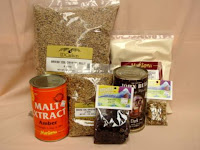 Time gets away from me! It has been two weeks since my last daily blog post. My webmaster is going to be all over my case about taking some time off! Actually, when you own a winery, there are times when other duties call and we have been busy filtering several tanks of wine and getting ready for a large bottling project.
Time gets away from me! It has been two weeks since my last daily blog post. My webmaster is going to be all over my case about taking some time off! Actually, when you own a winery, there are times when other duties call and we have been busy filtering several tanks of wine and getting ready for a large bottling project.Anyway, our latest blog posts have been focusing on homebrew ingredients and the steps involved in the beer brewing process and today we are going to focus on the homebrewing equipment you will need.
BlueStem Winery has several equipment packages that range in price from the mid-$50 range up to the mid-$80 range and these kits include all the basic equipment required for homebrewing with the exception of a brewpot, a floating thermometer and bottles (or kegs).
Since we are focusing on beginning beer making we will itemize only the basic equipment included in these homebrewing equipment kits. Basic equipment included with our beer making kits include various combinations of the following equipment:
6.5 gallon primary fermentation bucket;
The primary fermentation bucket, the bottling bucket and the lid for these are all food grade plastic. The primary fermentation bucket is where your beer is placed after the boil has been completed and you are ready to begin fermenting your beer (known as wort until it ferments). The fermentation process is completed in this container and then, if you have a secondary fermenter, the beer is siphoned to it. If you do not purchase equipment which includes a secondary fermenter (glass carboy) then you would siphon the beer from the fermentation bucket to the bottling bucket when fermentation is complete.
The bottling bucket has been pre-drilled to accommodate an Italian Bottling Spigot. The siphon tubing is attached to the nozzle on the spigot and when you are ready to bottle you can gravity-flow your beer from the bucket, through the spigot and tubing and through the bottle filler into your bottles. Our Bottle Filler is the spring-tip type which requires that you press down on the bottle filler to begin the flow of beer into the bottle. If you prefer, you may remove the spring and beer will flow as soon as the valve tip touches the bottom of the bottle.
Our kits all included 8 ounces (enough for about 16 gallons) of Easy Clean cleansing powder. All equipment used should be washed with dish soap and then rinsed with water. You may then rinse your equipment with cleansing solution and begin making your beer. Everything you use must be washed, rinsed and sanitized prior to it touching your beer. Many other cleansing products are available (some much stronger than Easy Clean). I have used Easy Clean for many batches of wine and homebrew and have yet to have a bacterial infection get started.
Some of our kits include an Auto-Siphon and others include a Racking Tube. The racking tube requires the attachment of siphon tubing and that you suck on the end of the tubing to get your siphon started. The auto-siphon also requires a length of tubing but it is a simple pull-push on the center section of the siphon which starts the process (very easy!).
The airlock is filled with water to the line and is attached to the bucket lid (through the grommeted hole) or is attached to a bung which is then inserted into the top of the carboy. This device allows for the escape of carbon dioxide gases created during the fermentation process while keeping pesky critters who like sugar away from your beer.
The Hydrometer is your most important tool. This is used to measure the beginning sugar content of your wort (expressed as specific gravity) and also measures the progress of the fermentation by measuring the decrease in specific gravity as the sugars ar fermented into alcohol.
The Beer Bottle Brush is exactly that. A brush for scrubbing out used beer bottles. Remember to sanitize these, too!
The Liquid Crystal Thermometer is attached to the side of your primary fermenter and is used to monitor the ambient temperature of your wort.
The Red Baron Bottle Capper has a magnet to hold the bottle cap and when tipped on top of your beer bottle, the twin levers crimp the bottle cap in place.
The text provided is a beginning brewing text. We always suggest that as you develop in this hobby that you purchase (available on our website) a copy of Charlie Papazian's text, the New Complete Joy of Homebrewing.
We look forward to hearing from you. We publish a newsletter quarterly on our BlueStem Winery website in addition to doing sometimes daily blog articles on either brewing or winemaking. We stock a complete line of home brewing equipment and home brew supplies plus a complete line of winemaking ingredients, equipment, supplies plus many, many wine ingredient kits from both WinExpert and Cellar Craft.







